11.3 MECHANICS OF THE DNA REPLICATION FORK
The advance of a replication fork requires the coordinated action of several different types of proteins, in addition to DNA polymerase. Many of these proteins work together as a highly dynamic “replisome” machine. Some proteins at a replication fork dissociate from the DNA and are replaced by new ones every few seconds, whereas others are left behind at intervals to direct clean-
Replication fork mechanics are best understood in the E. coli system, where the process is streamlined and illustrates the fundamental mechanism of a moving replication fork. Even so, more than a dozen different proteins are involved (Table 11-2). We describe here the individual replication proteins and how they act together at a replication fork in E. coli, then describe replication mechanisms in eukaryotes. Cellular processes in eukaryotes are generally more complex, and thus it is not surprising that several more proteins are involved at the replication fork.
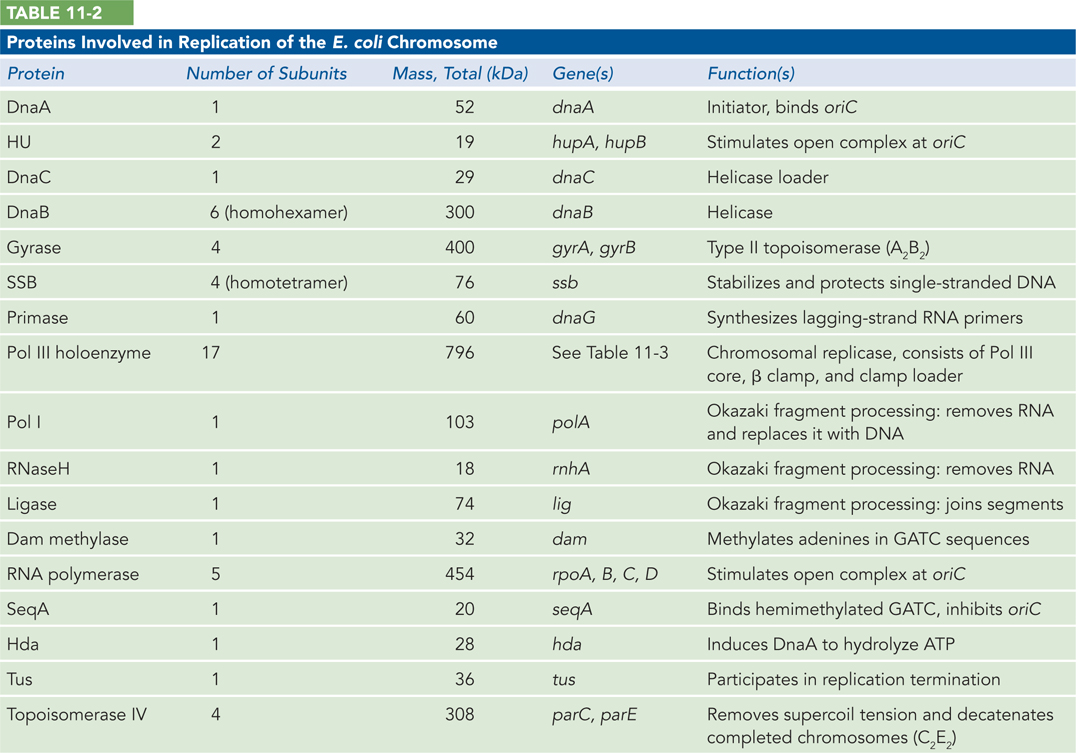
DNA Polymerase III Is the Replicative Polymerase in E. coli
Pol III is responsible for replicating the E. coli chromosome. The Pol III core is a heterotrimer composed of three subunits called α, ε, and θ. The DNA polymerase activity is in the α subunit; the ε subunit has the proofreading 3′→5′ exonuclease activity. The role of the θ subunit is currently unknown. The crystal structure of the Pol III α subunit, shown in Figure 11-13, reveals the hand shape common to all DNA polymerases and the presence of a polymerase domain and a histidinol phosphate (PHP) domain. The PHP domain, unique to bacterial Pol III, has a chain folding pattern similar to that of certain phosphodiesterases, suggesting that this domain may be a vestigial 3′→5′ exonuclease. In E. coli, as in many bacteria, the PHP domain is not enzymatically active, and the α subunit recruits the ε subunit for 3′→5′ proofreading activity. In some bacteria, however, the PHP domain in the α subunit is, in fact, the 3′→5′exonuclease proofreading activity, and these α subunits might not recruit an ε subunit.
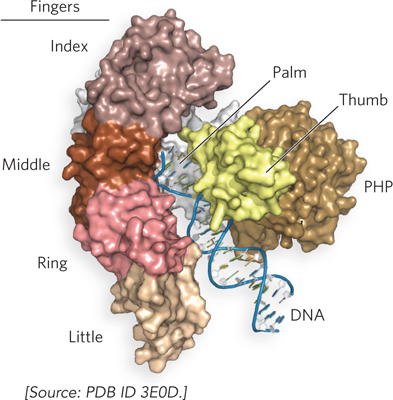
378
The Pol III core is just one part of a much larger protein assembly called the Pol III holoenzyme, which replicates both leading and lagging strands (Table 11-3). The Pol III holoenzyme includes three Pol III cores, two ring-

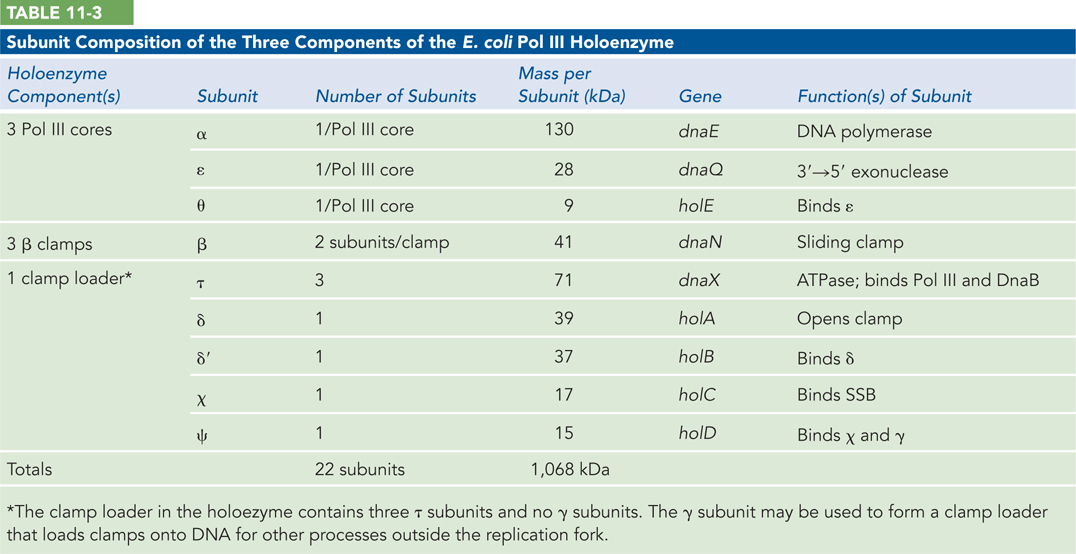
The Pol III core itself is capable of DNA synthesis at a slow rate, but DNA synthesis by the Pol III holoenzyme is exceedingly rapid, nearly 1 kb/s. The β clamps and clamp loader help maintain contact between the Pol III core and DNA, making the Pol III core highly processive (∼100 kb per binding event). Having two DNA polymerases in one holoenzyme assembly facilitates the coordinated synthesis of the leading and lagging strands at the replication fork. The β sliding clamps are assembled onto both DNA strands by the single clamp loader.
379
A DNA Sliding Clamp Increases the Speed and Processivity of the Chromosomal Replicase
The processivity (1 to 10 nucleotides) and rate of synthesis (10 nucleotides per second) of the Pol III core are dramatically enhanced by the β sliding clamp. The β clamp is a homodimer, shaped like a ring that encircles the duplex DNA (Figure 11-15a). The β clamp has sixfold symmetry; it is constructed from a single domain repeated three times in each monomer. The topological binding of the β clamp to DNA allows the clamp to slide along the duplex while staying tightly attached (see the How We Know section at the end of this chapter). The β clamp binds to the Pol III core (Figure 11-15b) and thereby holds Pol III to the DNA while sliding along the duplex. This converts Pol III core from a distributive enzyme, which moves on and off DNA as it works, to a processive enzyme that stays attached to DNA during repetitive cycles of dNMP incorporation (Figure 11-16).
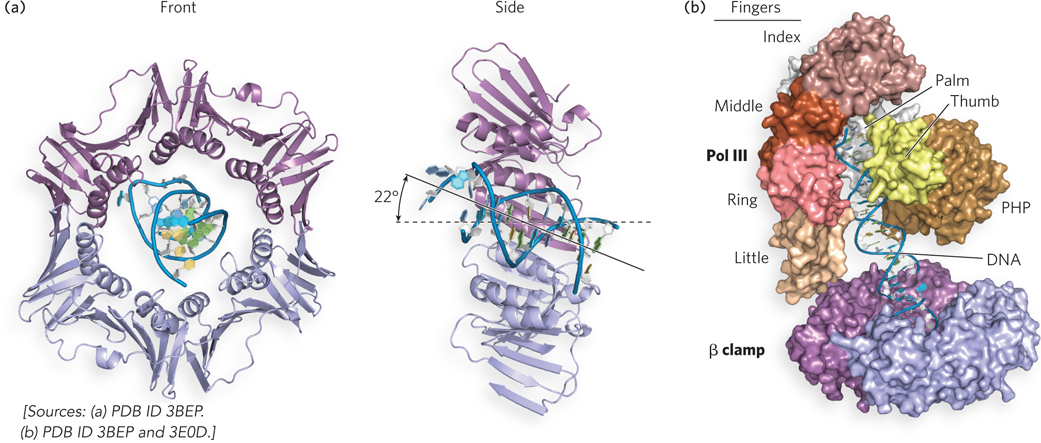
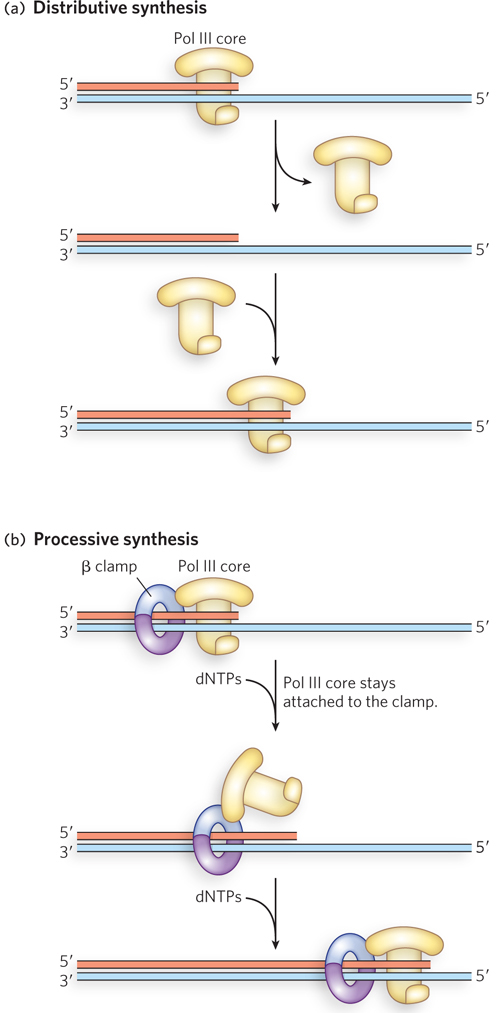
An example of the remarkable speed and processivity conferred on the Pol III core by the β clamp is shown in Figure 11-17. The DNA substrate used in this experiment was the large (5.4 kb), single-
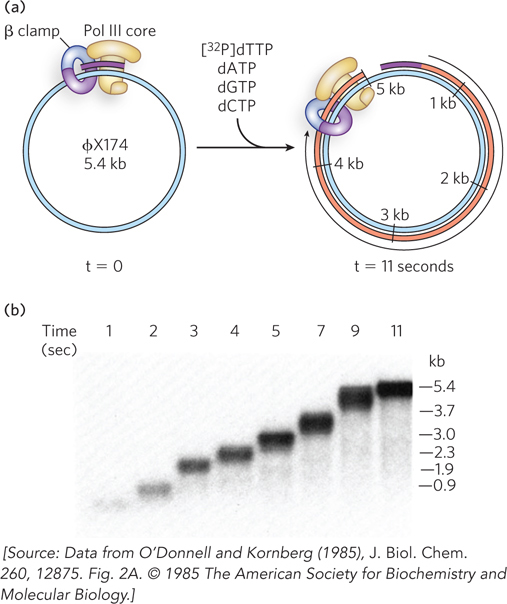
The β sliding clamp does not assemble onto DNA by itself; it requires the multiprotein clamp loader to open and close the ring around the DNA. The clamp loader within the Pol III holoenzyme is the τ complex, which consists of several subunits, τ3 (τ trimer), δ, and δ′, arranged in a circular pentamer (see Figure 11-14), and two small subunits, χ (chi) and ψ (psi), that connect to other proteins at the replication fork. The clamp loader uses the energy of ATP binding to open the β sliding clamp. In this operation, the clamp loader binds to one of the flat surfaces of the clamp and forces it to open (Figure 11-18a). The gene that encodes the τ subunit (dnaX) also produces a shorter version, called γ, through a translation frameshift event. During translation frameshifting, the mRNA slips and places the mRNA in a different reading frame. In the case of dnaX, the new reading frame results in a stop codon after one amino acid, thus yielding a δ subunit that is about 2/3 the size of τ. The τ and γ subunits form homotrimers (τ3 and γ3), and each can assemble with δ, δ′, χ, and ψ to form a clamp loader, either a τ complex or a γ complex. Only the τ complex binds to Pol III cores for DNA replication. As described in Chapter 12, sliding clamps are used by many different proteins for a variety of purposes, not just for replication. The γ complex is used to assemble β clamps onto DNA for use by enzymes other than Pol III.
380
The clamp loader has an inner chamber that binds primed DNA, and this positions the DNA through the sliding clamp. The clamp-
In the absence of ATP, the clamp loader cannot bind the β clamp, because the subunits are oriented in a way that blocks their interaction with the clamp. ATP binding to the τ (or γ) subunits induces a conformational change that enables the clamp loader to bind and open the clamp (as shown for the γ complex in Figure 11-18b). ATP is also needed for the clamp loader to bind DNA. ATP hydrolysis causes the clamp loader to revert to the form that cannot bind the β clamp or DNA, thereby ejecting the clamp loader and allowing the clamp to close around DNA. It is important that the clamp loader be ejected at the end of the reaction because it binds to the same spot on β to which the Pol III core must attach.
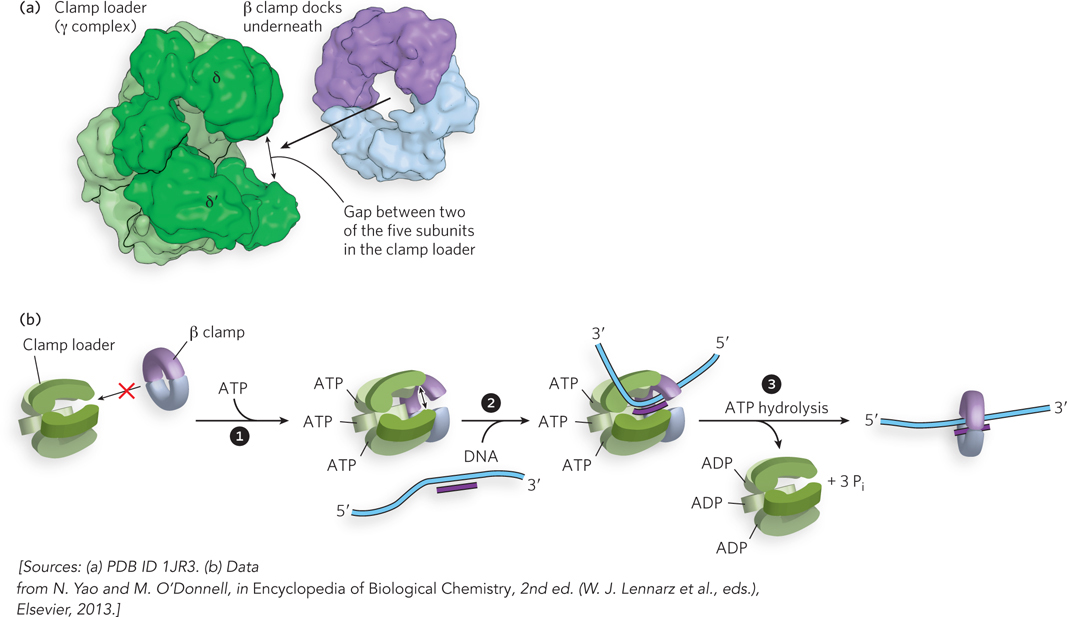
 ATP binding to the γ subunits powers a conformational change that enables the binding and opening of the β clamp.
ATP binding to the γ subunits powers a conformational change that enables the binding and opening of the β clamp.  The combined γ complex–
The combined γ complex– ATP hydrolysis ejects the clamp loader, allowing β to close again around the DNA.
ATP hydrolysis ejects the clamp loader, allowing β to close again around the DNA.381
Many Different Proteins Advance a Replication Fork
The simultaneous replication of both DNA strands at a replication fork requires the interaction of many proteins in addition to the Pol III core and β clamp (Figure 11-19a). Here we give particular attention to the E. coli system, but all cells contain these basic protein components for chromosome replication.
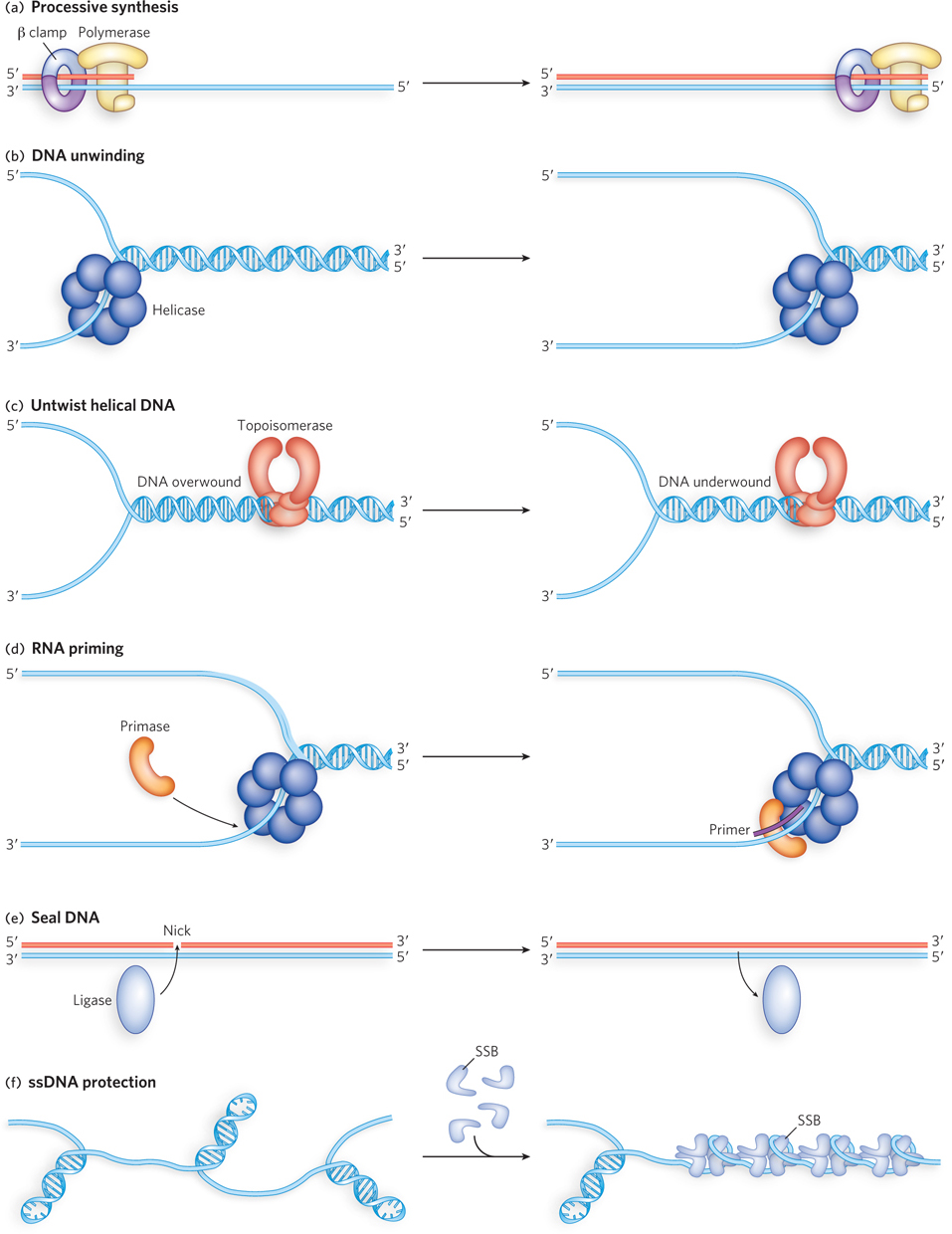
DNA Helicase The two strands of the parental DNA duplex are separated by a class of enzymes known as DNA helicases, which harness the energy of NTP hydrolysis (usually ATP) to drive strand separation (Figure 11-19b). Helicases are used in a wide variety of DNA and RNA transactions. DNA helicases usually load onto DNA at a single-
KEY CONVENTION
A helicase translocates along a single strand of DNA in one direction, parting the duplex as it moves. The direction of movement is specified, by convention, as the direction along the strand to which the enzyme is bound. If the helicase binds to a DNA strand and progresses from the 5′ end toward the 3′ end, it is said to be a 5′→3′ helicase.
Helicases that function at a replication fork are typically ring-
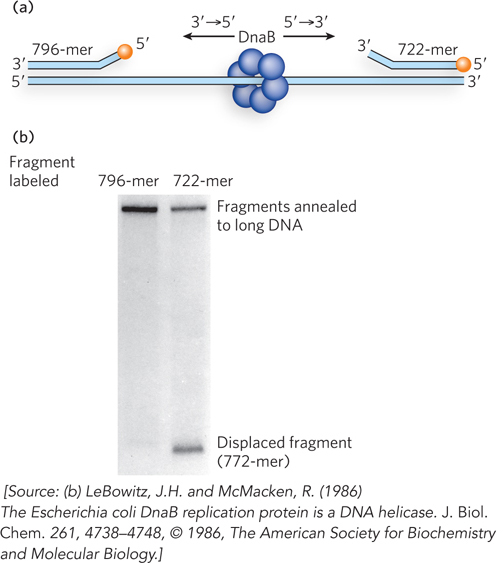
382
383
Topoisomerase As helicase separates the two strands of DNA, the duplex DNA ahead of the helicase becomes overwound, and this creates superhelical tension ahead of the fork. This occurs because the helicase cannot untwist the DNA strands. The action of untwisting DNA requires a special type of enzyme that cuts one or both strands of DNA to unwind it, then reseals it. This untwisting action is performed by topoisomerases that act on duplex DNA ahead of the replication fork (Figure 11-19c). There are many different kinds of topoisomerase. In E. coli, gyrase is the primary replicative topoisomerase, although topoisomerase IV also participates (see Chapter 9).
Primase As discussed earlier, DNA polymerase requires a preformed primer from which to elongate. Cells contain specialized RNA polymerases called primases that synthesize short RNA primers specifically for initiating DNA polymerase action. In E. coli, an RNA primer of 11 to 13 nucleotides is synthesized by the DnaG primase. RNA primers are needed to initiate each of the thousands of Okazaki fragments on the lagging strand. The leading strand is initiated by primase at a replication origin. E. coli DnaG primase must bind the DNA helicase for activity, and this localizes primase action to the replication fork (Figure 11-19d). RNA synthesis is less accurate than DNA synthesis (see Chapter 15), and the use of RNA to prime DNA synthesis provides a way for DNA polymerase I to recognize and remove the less accurate primer before Okazaki fragments are joined together. Note that although DNA polymerases will extend DNA primers as well as an RNA primer, in cells, only RNA is used to initiate DNA synthesis. It is not clear why this is the case. One possibility is that the task of forming the first phosphodiester bond, to create a dinucleotide, is more difficult than forming subsequent bonds, because two NTPs must be held by the enzyme at the same time, and the much higher concentration of rNTPs than dNTPs in the cell may be required for this first step.
Pol I and Ligase RNA primers must be removed at the end of each Okazaki fragment and replaced with DNA. This is achieved through the nick translation activity of Pol I (see Figure 11-7), which removes the ribonucleotides of the primer while simultaneously replacing them with deoxyribonucleotides. A ribonuclease called RNaseH can also remove RNA that is base-
Once all RNA is replaced with DNA, the nick in the phosphodiester backbone is sealed by DNA ligase in a reaction that requires ATP (or NAD+ in E. coli) (Figure 11-19e; see also Figure 5-12). Ligase acts only on a 5′ terminus of DNA, not on RNA. This specificity ensures that all the RNA at the end of an Okazaki fragment is removed before the nick is sealed. Both ligase and Pol I interact with the β sliding clamp.
384
SSB Single-
Helicase Activity Is Stimulated by Its Connection to the DNA Polymerase
The E. coli DnaB helicase connects to the Pol III holoenzyme through the τ subunits of the clamp loader within the Pol III holoenzyme. Without this connection to polymerase, DnaB helicase is slow, unwinding about 35 bp/s. On connection of DnaB to the Pol III holoenzyme, unwinding proceeds at a rate of approximately 700 bp/s. The complex of Pol III holoenzyme, DnaB helicase, and primase forms a replisome. The three τ subunits of the τ complex clamp loader bind three Pol III cores, and these same τ subunits also bind the DnaB helicase. Figure 11-21 shows one Pol III core associated with the leading strand and one with the lagging strand; as we will see later, the third Pol III core also participates in replication of the lagging strand. The leading-
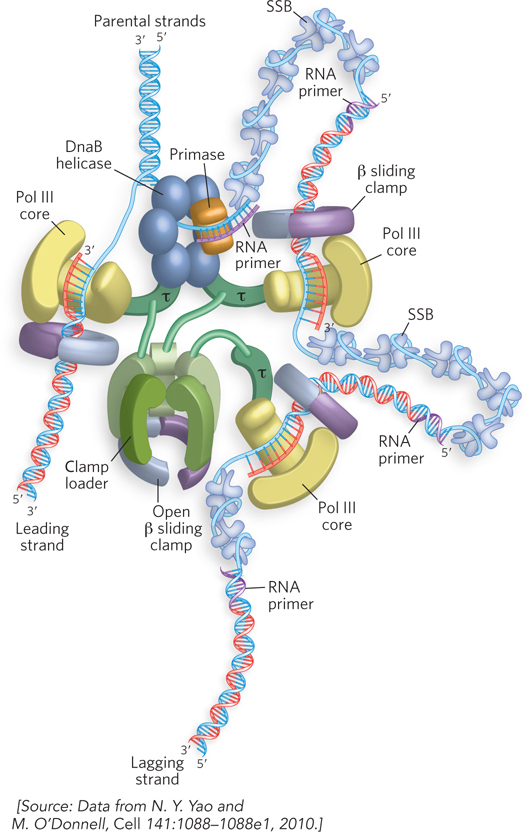
DNA Loops Repeatedly Grow and Collapse on the Lagging Strand
The lagging-
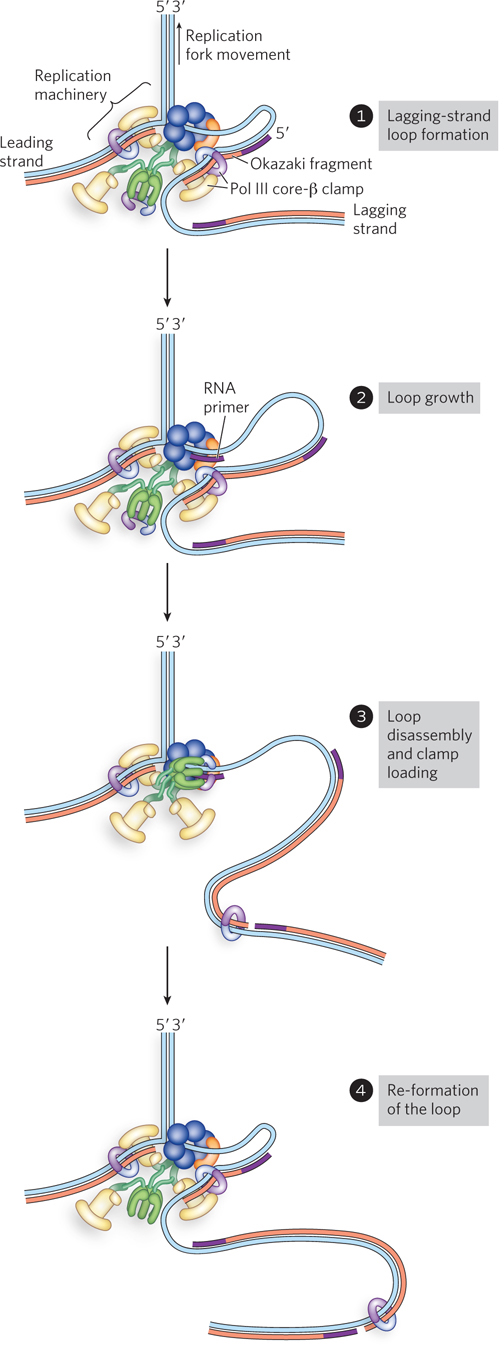
385
When the lagging-

Recent studies have shown that two of the three Pol III cores of the Pol III holoenzyme can function to replicate the lagging strand while the third continuously replicates the leading strand. These actions are illustrated in Figure 11-23. First, two polymerases are shown, one on each strand (step 1). As the Okazaki fragment is being extended by the first lagging-
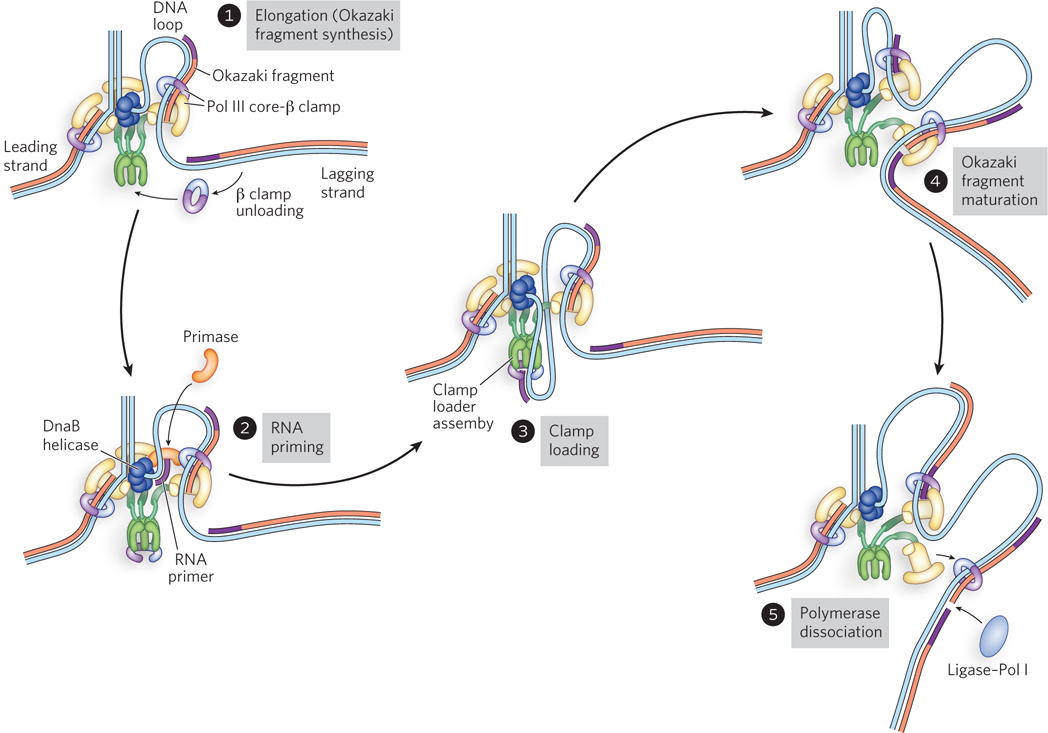
 Two Pol III cores are attached to β clamps on the leading and lagging strands, creating a loop.
Two Pol III cores are attached to β clamps on the leading and lagging strands, creating a loop.  Primase binds to DnaB helicase and synthesizes an RNA primer (purple).
Primase binds to DnaB helicase and synthesizes an RNA primer (purple).  The clamp loader assembles a β clamp onto the new RNA primer.
The clamp loader assembles a β clamp onto the new RNA primer.  The second lagging-
The second lagging- The first lagging-
The first lagging-Experiments using a simple model system first suggested that Pol III hops from one β clamp to another to cycle among Okazaki fragments on the lagging strand (Figure 11-24). The Pol III holoenzyme was assembled on a 5.4 kb DNA substrate (M13mp18), then mixed with two competing DNA substrates of different sizes (M13Gori and φX174), each with one site primed for DNA synthesis. In each of two experiments, only one of the competing DNAs included a β clamp at the primed site. Replication was initiated using [32P]dNTPs, and timed aliquots were analyzed by agarose gel electrophoresis and autoradiography. As the result in Figure 11-24b shows, Pol III replicated the initial 5.4 kb DNA, then transferred to the DNA substrate that included the preassembled clamp. Because the competing DNA with a preassembled β clamp was preferentially replicated compared with the DNA lacking a clamp, the result suggests that Pol III leaves the β clamp behind on the first template, then hops to another DNA that has a new β clamp. Further studies confirmed that Pol III indeed hops from one clamp to another, leaving clamps behind on the DNA as it does so.
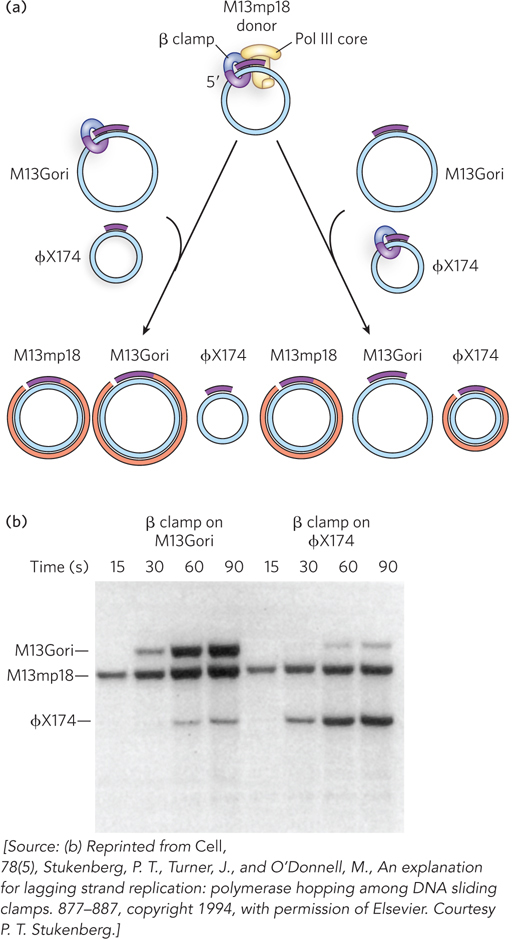
386
Okazaki Fragments Require Removal of RNA and Ligase-Mediated Joining of DNA
The RNA at the 5′ terminus of each Okazaki fragment must be removed and the gap filled in with DNA. This job is performed by the nick translation activity of Pol I (see Figure 11-7). As noted earlier, the cell also has a backup enzyme, RNaseH, which can remove the RNA, in which case the single-
387
Okazaki fragments outnumber β clamps in the cell by about 10 to 1, so clamps must be recycled during chromosome replication. Clamps are removed from DNA by the δ subunit of the clamp loader, which is produced in excess in the cell (relative to the other clamp loader subunits). By itself, the δ subunit can open and unload a β clamp from DNA, but it cannot assemble a clamp onto DNA.
The β clamp binds many proteins, including all five E. coli DNA polymerases, ligase, the clamp loader complex, and several proteins not described in this chapter. These proteins all bind to the same spot on β. Therefore, when the β clamp is being used by a DNA polymerase or another protein, the recycling of β is blocked. Only when the clamp is no longer bound by other proteins is it available to be recycled (Figure 11-25).
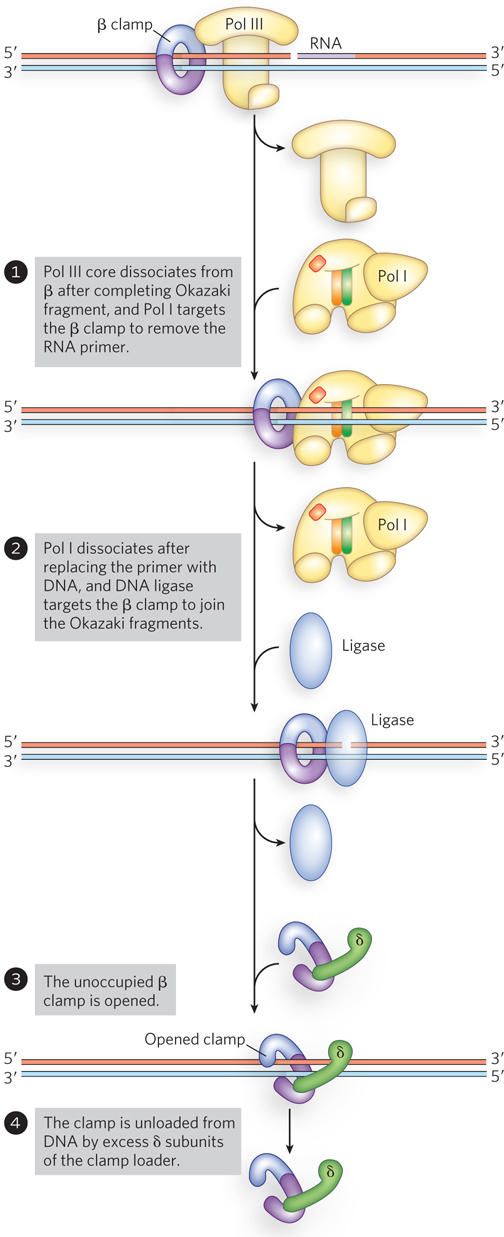
The Replication Fork Is More Complex in Eukaryotes Than in Bacteria
Many eukaryotic replication proteins have counterparts in bacteria (e.g., the clamps and clamp loader), but the replication fork machinery of eukaryotes includes more proteins beyond those used in the comparatively simple bacterial machinery (Figure 11-26). New eukaryotic replication factors are still being identified, and details of the replication fork in eukaryotic cells are only now coming into focus.
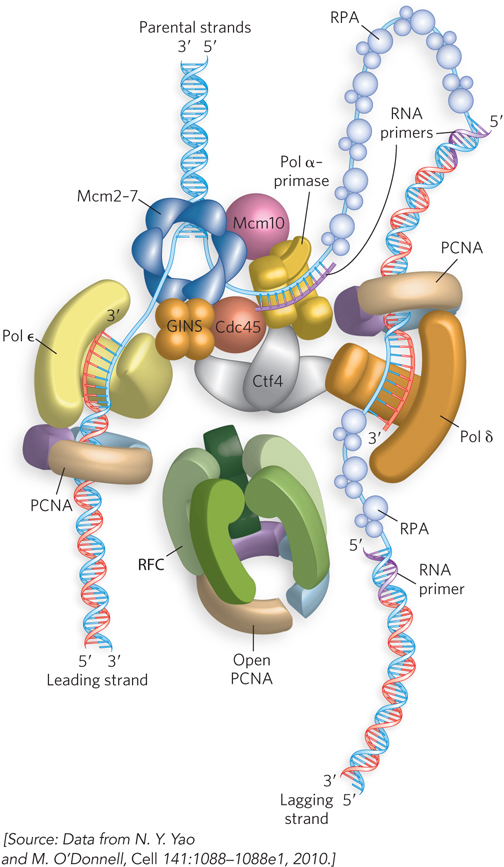
The MCM complex is thought to function at the replication fork. Like E. coli DnaB, the MCM subunits form a ring-
388
The eukaryotic primase is a four-
Eukaryotes have two different chromosomal replicases: DNA polymerase δ (Pol δ) and DNA polymerase ε (Pol ε). Both Pol δ and Pol ε are four-
389
Both Pol δ and Pol ε interact with a DNA sliding clamp called PCNA (proliferating cell nuclear antigen). PCNA looks remarkably like the E. coli β clamp (Figure 11-27a). The two proteins share no sequence homology, but the three-
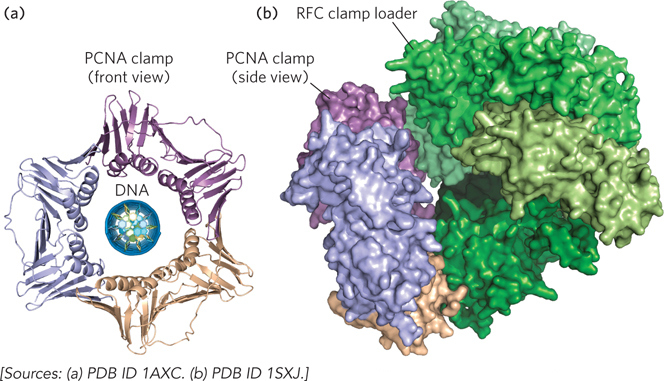
The eukaryotic replication machinery also includes several other proteins associated with the CMG complex. The complex was isolated from cells using highly selective antibodies directed against CMG subunits. The large protein assemblage is referred to as the replisome progression complex (RPC), and its subunit composition has been identified by mass spectrometry. Among the proteins identified in this fashion are Ctf4 and Mcm10, proteins that move with replication forks in vivo and are essential for cell viability (except in yeast, where Ctf4 is not essential). Ctf4 binds to both GINS and Pol α, acting as a bridge to affix Pol α in the replisome. The role of Mcm10 is presently unknown. RPCs also contain several nonessential proteins that are thought to control the rate of replication during times of cellular stress.
Eukaryotic replication forks proceed at a rate of about 30 to 50 nucleotides per second, far slower than bacterial forks. Also, eukaryotic Okazaki fragments are considerably shorter than bacterial Okazaki fragments, only 100 to 200 nucleotides. The heterotrimeric replication protein A (RPA) is the functional equivalent of E. coli SSB.
Additional proteins of the eukaryotic replication machinery have functions in finishing and sealing Okazaki fragments. On completing an Okazaki fragment, Pol δ performs limited strand displacement, lifting the RNA primer synthesized by Pol α. The RNA is then excised by a 5′→3′ nuclease called Fen1, and DNA ligase I then joins the fragments. This process often removes some of the DNA made by Pol α. An alternative pathway for RNA primer removal comes into play when strand displacement has proceeded farther than normal; this is accomplished by the Dna2 nuclease, which can excise longer tracts of displaced RNA and DNA than Fen1.
The identity and arrangement of proteins that function at the replication fork in eukaryotes are still the subject of intense investigation. Several proteins with functions that, as yet, lack clear definition seem to be involved in the architecture of the eukaryotic replication fork. The numbers and types of proteins currently thought to participate in eukaryotic chromosome replication are summarized in Table 11-4.
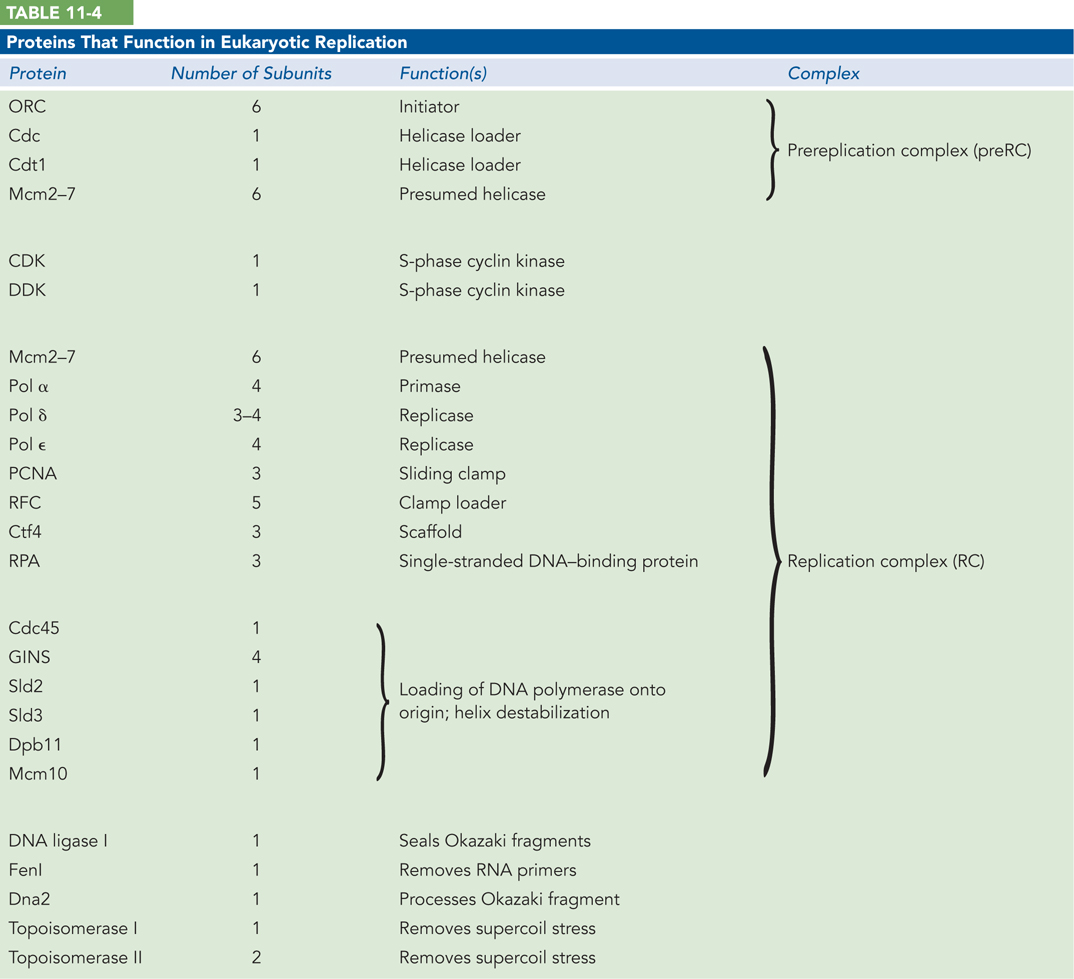
390
SECTION 11.3 SUMMARY
The E. coli chromosomal replicase, the Pol III core, connects to the ring-
shaped β sliding clamp that encircles DNA for processive DNA synthesis. The β clamp is assembled onto DNA by a multiprotein clamp loader. Three Pol III cores, three β clamps, and one clamp loader complex form the Pol III holoenzyme assembly. The Pol III holoenzyme, DnaB helicase, and DnaG primase form the replisome complex. The hexameric DnaB helicase encircles the lagging strand and uses ATP to unwind DNA at the replication fork. DnaG primase forms RNA primers to initiate DNA synthesis.
Topoisomerases act ahead of the replication fork to remove superhelical tension generated by DNA unwinding. SSB binds the single-
stranded DNA created by the unwinding action of helicase, preventing the formation of secondary structures in the DNA and protecting it from endonucleases. RNA primers are removed from finished Okazaki fragments by the nick translation action of Pol I, and the processed fragments are joined by DNA ligase.
Simultaneous replication of the two antiparallel strands of duplex DNA by two Pol III cores in the replisome requires loops to form on the lagging strand that repeatedly grow and reset for each Okazaki fragment.
391
Eukaryotes have two different multiprotein DNA polymerases (Pol ε and Pol δ) that function on the leading and lagging strands. These DNA polymerases connect to PCNA sliding clamps that are loaded onto the DNA by the RFC clamp loader.
Eukaryotes have functional counterparts for each E. coli replication fork protein, but the eukaryotic replisome is more complex. The eukaryotic primase is a four-
subunit enzyme (Pol α) that has both DNA polymerase and primase activities. The CMG helicase has 11 subunits: an Mcm2– 7 heterohexamer, GINS heterotetramer, and Cdc45. The eukaryotic SSB homolog, RPA, has three different subunits. Several other eukaryotic proteins that travel with the fork have no known homologs in bacteria.